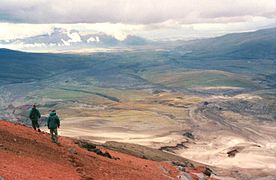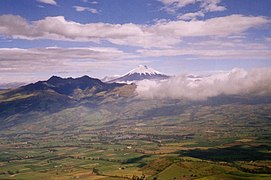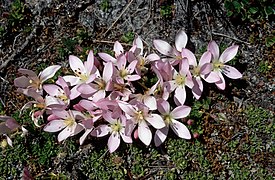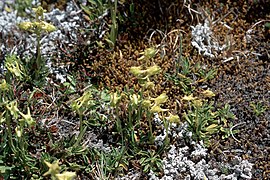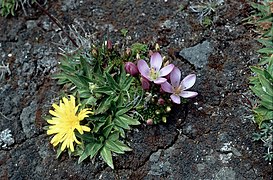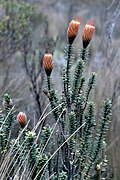Cotopaxi
| Cotopaxi | ||
|---|---|---|
|
The Cotopaxi |
||
| height | 5897 m | |
| location | Ecuador | |
| Mountains | To the | |
| Dominance | 96.67 km → Chimborazo | |
| Notch height | 2404 m ↓ saddle between Rumiñahui and Illinois | |
| Coordinates | 0 ° 41 ′ 3 ″ S , 78 ° 26 ′ 14 ″ W | |
|
|
||
| Type | Stratovolcano | |
| Last eruption | 2015 | |
| First ascent | Nov 28, 1872 Wilhelm Reiss | |
At 5897 m, the Cotopaxi is the second highest mountain in Ecuador and one of the highest active volcanoes on earth. While active, it is the country's most climbed mountain and one of the most visited peaks in South America.
topography
The Cotopaxi is located in the national park named after it in the Ecuadorian province of the same name, Cotopaxi, about 50 kilometers south of Quito . It belongs to the " avenue of volcanoes " in the eastern Andes .
As an Ecuadorian mountain, the Chimborazo is higher at 6310 m , but no longer volcanically active. The world's highest active volcano is currently the 6,893 m high Ojos del Salado in Argentina / Chile .
With its regular, conical shape and the ice cap on the summit, the Cotopaxi corresponds to the ideal of a stratovolcano . The crater has a diameter of 800 meters × 550 meters at the summit and is about 350 meters deep.
history
The name Cotopaxi means "neck of the moon" because from a certain perspective the moon rises behind the mountain. For a short time the moon stands as the "head" directly above the summit. The snow-covered part of the mountain can be seen as a poncho .
The local peoples of the region considered the mountain to be a sacred mountain even before the beginning of the Inca rule in the 15th century . He was revered as a source of rain and thus a guarantee for the fertility of the land and as the seat of gods.
The first European who tried to climb the mountain was Alexander von Humboldt in 1802. He reached an altitude of about 4500 m . In the 1850s, the American painter Frederic Edwin Church made large-format views of the volcano on his two painting expeditions.
In 1858 Moritz Wagner explored the mountain, but even he could not reach the summit. The geologist Wilhelm Reiss succeeded in doing this on November 27, 1872 . In 1873 Moritz Alphons Stübel and in 1880 Edward Whymper climbed the Cotopaxi. The ascent through the painter Rudolf Reschreiter and Hans Meyer became known in 1903. Reschreiter made several paintings of the mountain.

Ascent
Nowadays the Cotopaxi is climbed almost every day. For this, climbs with mountain guides are offered by Ecuadorian travel agencies; approval is not required. Today it is possible to drive up to 4658 m by car. The José Ribas refuge is located at an altitude of 4800 m , where tourists can spend the night and from which the ascent begins shortly after midnight. Experienced and acclimatized mountaineers need between six and eight hours to climb the normal route.
Volcanism
The Cotopaxi has erupted around 50 times since 1738. Of these, the most powerful eruptions were those of 1744, 1768 and 1877. The great eruption in 1877 completely melted the summit glacier, so that the resulting mudslide flooded the surrounding land for more than 100 km and completely destroyed the city of Latacunga .
The last major eruption was in 1904, followed by several small eruptions until 1940. The last major activity in 1975/76 consisted of an increase in temperature, smoke formation and smaller earthquakes. Even today, smoke emissions can often be observed. On August 14, 2015, an 8 km high ash cloud formed, and explosions occurred inside the volcano. The alert level was raised to medium. The next day imposed Ecuador's President Rafael Correa the state of emergency across the country. The general state of emergency was imposed one day after nationwide protests against a constitutional amendment that would allow Correa to stand for re-election as president indefinitely, as well as after a nationwide general strike. Although the danger emanating from the volcano is great, the Secretariat for Risk Management only issued the lowest alert (yellow). The volcano was in an active eruption phase in 2015 with high internal and moderate external activity and continuously emitted gas and ash.
photos
Cotopaxi and Rumiñahui
Flora at Cotopaxi
See also
Web links
- Site at the geophysical institute Ecuador
- Cotopaxi in the Global Volcanism Program of the Smithsonian Institution (English)
- NASA satellite image of the volcano
- fieldmuseum.org
- Ascent on the normal route
- detailed experience report on a guided ascent
Individual evidence
- ↑ Jordan, E (1983) The glaciation of the COTOPAXI - Ecuador. Journal of Glacier Science and Glacial Geology, 19 (1) , 73–102.
- ↑ a b Karl Gratzl: The Mountain Myth. Lexicon of the important mountains from mythology, cultural history and religion . Hollinek, Purkersdorf 2000, ISBN 3-85119-280-X , p. 70-71 .
- ↑ Ekkehard Radehose: Traumberge Amerikas Bergverlag Rother, Munich 1996, p. 71
- ↑ On walking in the ice in the Frankfurter Allgemeine Sonntagszeitung on July 27, 2014, page V3
- ↑ http://iptv.orf.at/#/stories/2293931/ Vulkanausbruch in Ecuador, ORF.at, August 15, 2015.
- ↑ http://www.igepn.edu.ec/servicios/noticias/1127-reporte-de-actividades-del-volcan-cotopaxi-boletin-de-prensa-coe-bol-no-1
- ↑ Cotopaxi volcano ejects ash: It is seething in Ecuador at taz.de, August 16, 2015 (accessed on August 17, 2015).
- ↑ http://www.dw.com/de/ausnahmestatus-in-ecuador-wegen-vulkan-verh%C3%A4ngt/a-18651758
- ↑ Archive link ( Memento of the original from September 24, 2015 in the Internet Archive ) Info: The archive link was inserted automatically and has not yet been checked. Please check the original and archive link according to the instructions and then remove this notice.
- ↑ Rapid Color Guide, The Field Museum Chicago - Plantas Llamativas de Cotopaxi




